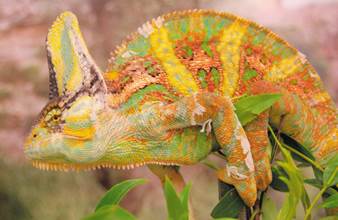有英勇气概的变色龙光芒最亮
来源:《Biology Letters》
作者:Russell A. Ligon等
时间:2013-12-25

战斗中的变色龙用复杂的颜色变化进行交流:身体不同区域传达不同的信息。
雄性变色龙在战斗中通过调整其皮肤颜色的亮度作为其侵略意图和实力的信号。
坦佩亚利桑那州州立大学Russell Ligon和Kevin McGraw筹划了成年雄性变色龙之间的战斗(高冠变色龙;图),并使用高清晰度视频追踪动物身体皮肤上28块斑点的颜色和亮度的变化。
身体条纹亮度高的个体更可能进攻另一个个体,而变色龙的头变亮的速度越快,其越有可能赢得比赛。
这两个信号可以帮助雄性变色龙区分潜在争斗者的斗争动机和战斗能力,竞争行为中的这两个因素对比赛结果有不同影响。(编译:中国科学院成都生物研究所 王芋华,王海燕)
Chameleons communicate with complex colour changes during contests: different body regions convey different information
Abstract Many animals display static coloration (e.g. of feathers or fur) that can serve as a reliable sexual or social signal, but the communication function of rapidly changing colours (as in chameleons and cephalopods) is poorly understood. We used recently developed photographic and mathematical modelling tools to examine how rapid colour changes of veiled chameleons Chamaeleo calyptratus predict aggressive behaviour during male–male competitions. Males that achieved brighter stripe coloration were more likely to approach their opponent, and those that attained brighter head coloration were more likely to win fights; speed of head colour change was also an important predictor of contest outcome. This correlative study represents the first quantification of rapid colour change using organism-specific visual models and provides evidence that the rate of colour change, in addition to maximum display coloration, can be an important component of communication. Interestingly, the body and head locations of the relevant colour signals map onto the behavioural displays given during specific contest stages, with lateral displays from a distance followed by directed, head-on approaches prior to combat, suggesting that different colour change signals may evolve to communicate different information (motivation and fighting ability, respectively)
原文链接:http://rsbl.royalsocietypublishing.org/content/9/6/20130892




